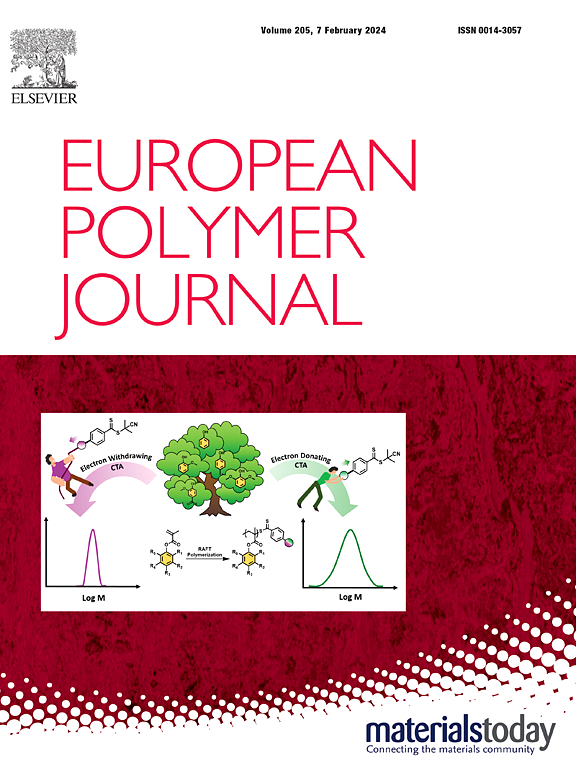Optimization of drying scheme for polyetherimide film to achieve ultra-high breakdown strength and enhanced energy storage performance
IF 5.8
2区 化学
Q1 POLYMER SCIENCE
引用次数: 0
Abstract
As one of potential candidates for fabricating high-power dielectric polymer capacitors, polyetherimide (PEI) has been paid much attention. However, energy storage performance of PEI films, especially discharge energy density, has demonstrated notable discrepancies among various studies. The reported maximum discharge energy densities of PEI are still below 7 J∙cm−3, and are closely related to the drying procedures. In this work, PEI films were meticulously synthesized via the solution casting method, with focusing on optimizing the drying procedures to enhance their energy storage performance. The PEI films were pre-dried at various temperatures for different durations. The different drying procedures do not cause change in chemical bonds of PEI. The optimized protocol involves a precise pre-drying step at 80 °C for 8 h in vacuum, seamlessly followed by further drying at 200 °C for 12 h. Pure PEI prepared via the optimized drying procedure exhibits the lowest glass transition temperature of 215.69 °C, exceptional breakdown strength of 678 MV∙m−1, and astounding discharge energy density of 8.48J∙cm−3, surpassing the majority of previously reported values. The work not only presents an effective simple method for developing high-performance pure PEI films, but also provides some guidance to enhance energy storage performance of polymer materials.

优化聚醚酰亚胺薄膜干燥方案,实现超高击穿强度和增强储能性能
聚醚酰亚胺(PEI)作为制造大功率电介质聚合物电容器的潜在候选材料之一,一直备受关注。然而,聚醚酰亚胺薄膜的储能性能,尤其是放电能量密度,在不同的研究中表现出明显的差异。已报道的 PEI 最大放电能量密度仍低于 7 J∙cm-3 ,这与干燥过程密切相关。在这项工作中,我们通过溶液浇铸法精心合成了聚乙烯醇薄膜,重点是优化干燥程序以提高其储能性能。PEI 薄膜在不同温度下进行了不同时间的预干燥。不同的干燥程序不会改变 PEI 的化学键。通过优化的干燥程序制备的纯聚乙烯醇表现出最低的玻璃化转变温度(215.69 °C)、超强的击穿强度(678 MV∙m-1)和惊人的放电能量密度(8.48J∙cm-3),超过了之前报道的大多数数值。这项工作不仅为开发高性能纯 PEI 薄膜提供了一种有效的简单方法,而且为提高聚合物材料的储能性能提供了一些指导。
本文章由计算机程序翻译,如有差异,请以英文原文为准。
求助全文
约1分钟内获得全文
求助全文
来源期刊

European Polymer Journal
化学-高分子科学
CiteScore
9.90
自引率
10.00%
发文量
691
审稿时长
23 days
期刊介绍:
European Polymer Journal is dedicated to publishing work on fundamental and applied polymer chemistry and macromolecular materials. The journal covers all aspects of polymer synthesis, including polymerization mechanisms and chemical functional transformations, with a focus on novel polymers and the relationships between molecular structure and polymer properties. In addition, we welcome submissions on bio-based or renewable polymers, stimuli-responsive systems and polymer bio-hybrids. European Polymer Journal also publishes research on the biomedical application of polymers, including drug delivery and regenerative medicine. The main scope is covered but not limited to the following core research areas:
Polymer synthesis and functionalization
• Novel synthetic routes for polymerization, functional modification, controlled/living polymerization and precision polymers.
Stimuli-responsive polymers
• Including shape memory and self-healing polymers.
Supramolecular polymers and self-assembly
• Molecular recognition and higher order polymer structures.
Renewable and sustainable polymers
• Bio-based, biodegradable and anti-microbial polymers and polymeric bio-nanocomposites.
Polymers at interfaces and surfaces
• Chemistry and engineering of surfaces with biological relevance, including patterning, antifouling polymers and polymers for membrane applications.
Biomedical applications and nanomedicine
• Polymers for regenerative medicine, drug delivery molecular release and gene therapy
The scope of European Polymer Journal no longer includes Polymer Physics.
 求助内容:
求助内容: 应助结果提醒方式:
应助结果提醒方式:


